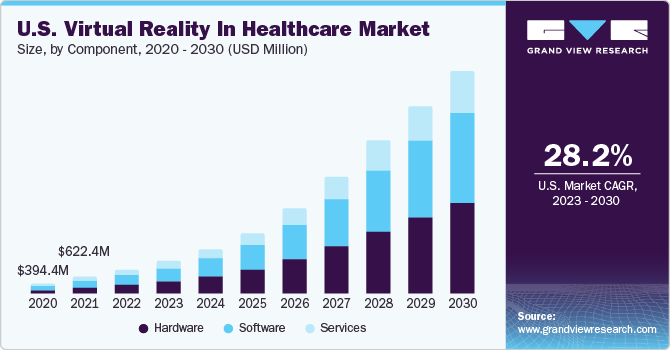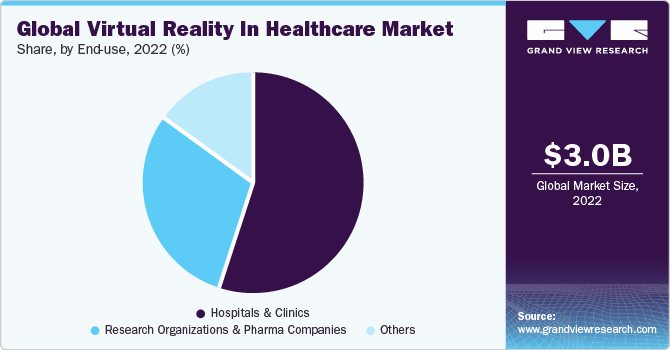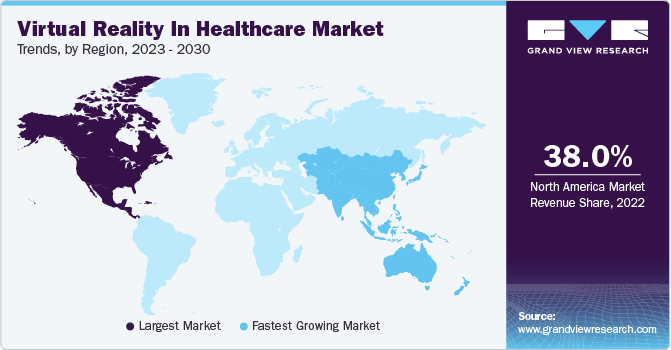- Home
- »
- Next Generation Technologies
- »
-
Virtual Reality In Healthcare Market Size, Share Report, 2030GVR Report cover
![Virtual Reality In Healthcare Market Size, Share & Trends Report]()
Virtual Reality In Healthcare Market Size, Share & Trends Analysis Report By Component (Hardware, Software, Services), By Device, By Application (Pain Management, Patient Care Management), By End-use, By Region, And Segment Forecasts, 2023 - 2030
- Report ID: GVR-4-68040-136-8
- Number of Report Pages: 160
- Format: PDF, Horizon Databook
- Historical Range: 2018 - 2021
- Forecast Period: 2023 - 2030
- Industry: Technology
VR In Healthcare Market Size & Trends
The global virtual reality in healthcare market size was estimated at USD 3.01 billion in 2022 and is expected to grow at a compound annual growth rate (CAGR) of 32.2% from 2023 to 2030. The increasing number of benefits offered by virtual reality (VR) in the healthcare domain, including improved surgical procedures, better pain management, telemedicine, medical training, patient education, and others are driving the market growth. Moreover, the growing prominence of digital solutions to provide highly efficient, patient-centered, and cost-effective healthcare to improve patient outcomes is favoring the market expansion further.

Virtual reality is being increasingly adopted in several areas of healthcare, such as diagnosis, surgical procedures, rehabilitation, pain management, and counseling. The increasing significance of this technology is urging the companies operating in virtual reality in the healthcare industry to introduce innovative solutions. For instance, in October 2022, XRHealth and HTC Corporation’s VIVE launched a distraction therapy VR platform for improving patient experience during painful medical procedures. This solution integrates XRHealth software with VIVE Flow glasses to distract patients and minimize pain during complex medical procedures, such as surgery, MRIs, chemotherapy, and others.
Favorable government initiatives are also expected to proliferate the growth of the market over the coming years. For instance, in April 2023, the U.S.’s Veteran Affairs Office of Healthcare Innovation and Learning signed a three-year collaboration deal with Penumbra to co-develop, test, and scale virtual reality (VR) solutions. These solutions are being designed to increase veteran access to rehabilitation care in community-based outpatient clinics and at home.
Component Insights
The hardware segment accounted for the largest revenue share of over 49% in 2022 due to increased demand for components such as head-mounted displays and smart glasses across healthcare settings amid the proliferation of telemedicine and virtual care. Moreover, they enable hands-free operation in surgical and non-surgical procedures using voice commands, allowing the clinicians to focus on patient care. In addition, these hardware components are useful in medical training as they simulate complex surgeries in a more immersive way, thereby enhancing the training methods. The growing usability of these components is expected to drive segmental growth in the coming years.
The software segment is anticipated to grow at the highest CAGR of over 35% from 2023 to 2030 with the introduction of various innovative VR-based applications (Apps) in the healthcare domain. These solutions help in enhancing patient care as well as improving medical training. For instance, XRHealth provides a virtual reality app named VRCogni Series that provides prescription-only medical applications to monitor and address conditions of cognitive function by providing ability measurement and exercise.
Device Insights
Based on device, the head-mounted display (HMD) segment accounted for the largest market share of nearly 62% in 2022 due to the increased adoption of such emerging technologies in the healthcare domain. HMDs play a major role in various medical applications, from training to clinical care. Their most practical feature in surgical and non-surgical settings is their ability to enable hands-free operation through voice commands and speech recognition. Moreover, HMDs are largely considered by healthcare providers as they offer patient data security and clinical usefulness, thereby significantly enhancing the clinician’s performance.
The gesture-tracking device (GTD) segment is projected to grow at the highest CAGR of over 34% from 2023 to 2030, owing to the important advantages offered by this technology. In the healthcare sector, this technology is being increasingly adopted in rehabilitation processes as it can track patients’ recovery by monitoring their hand movements and helping them regain motor skills. In surgical procedures, GTD allows surgeons to manipulate medical images and access patient data without the need to touch a screen or keyboard physically.
Application Insights
The patient care management segment accounted for the highest market share of around 31% in 2022, driven by the growing emphasis on enhancing patient experiences and outcomes. With the increasing adoption of VR technologies in healthcare settings, patient care management applications are gaining traction as they offer immersive and personalized patient solutions, ranging from pain distraction therapies to anxiety reduction interventions. Moreover, the COVID-19 pandemic has accelerated the adoption of telehealth and virtual patient care, creating a conducive environment for VR-based solutions to flourish in providing remote patient support and monitoring.
The rehabilitation & therapy procedures segment is expected to grow at the highest CAGR of over 33% from 2023 to 2030. The growth of the segment can be attributed to the various advantages that VR provides when incorporated into the rehabilitation process of patients with certain conditions. It not only facilitates patient education, flexibility, motivation, and variability but also helps reduce medical costs for the healthcare system and efficient use of resources according to the patient’s history and accessibility of data. The increasing usage of VR in treating neurological conditions, orthopedic conditions, and pediatric diseases is contributing to segmental growth.
End-use Insights
Based on end-use, the hospitals & clinics segment accounted for the largest market share of over 55% in 2022 and is projected to dominate the market over the forecast period. This can be attributed to the increased adoption of VR for various important applications, such as medical training, simulation, pain management, surgeries, and others. Besides, increased investment in advanced technologies in these healthcare settings is expected to provide positive growth prospects for the market. Moreover, increasing adoption of VR to provide rehabilitation to patients with the help of built-in VR software programs or virtual therapists is also favoring segmental growth.

The research organizations & pharma companies segment is anticipated to grow at the highest CAGR of over 32% from 2023 to 2030. The notable growth can be attributed to the increased adoption of VR solutions across these organizations to create virtual environments for patient trials, facilitating the testing of drugs in more realistic settings. Moreover, VR plays a crucial role in drug development as it can simulate molecular structures, enabling the researchers to better understand the interactions of the drugs with their targets. Such vital applications of VR technology are expected to drive the segment’s growth over the forecast period.
Regional Insights
North America accounted for around 38% of revenue share in 2022 owing to greater consumer proclivity for virtual reality solutions coupled with favorable government initiatives in the region. In addition, the strong presence of various market players focusing on introducing innovative solutions to cater to changing consumer demands is driving the regional market growth further. The regional healthcare settings, such as hospitals, clinics, ambulatory care, and others are making significant investments in VR solutions. For instance, in June 2023, The Nicklaus Children’s Hospital in Miami, U.S., used a VR headset to transform the needle phobia in children into a virtual and friendly simulation. Such initiatives are expected to enhance the market outlook over the forecast period.

Asia Pacific is expected to record a CAGR of more than 35% from 2023 to 2030. The market's growth can be attributed to the growing awareness regarding improved healthcare infrastructure across countries such as China and India. The increasing number of healthcare settings equipped with advanced therapeutic solutions is expediting the market expansion to a great extent. For instance, in February 2022, Apollo Hospitals entered into a collaboration with 8chili Inc, a U.S.-based deep-tech startup to implement virtual reality for increasing patient outcomes by providing generic environments consisting of relaxing narratives that induce control over body and physiological response.
Key Companies & Market Share Insights
The companies operating in the market are focusing on forming strategic alliances and launching new products to strengthen their foothold in the competitive business environment. For instance, in May 2023, XRHealth, a prominent provider of virtual treatment rooms, delivered the Snapdragon Spaces XR Developer Platform for the Lenovo ThinkReality VRX. This initiative will help developers at XRHealth create immersive experiences in Augmented Reality, Virtual Reality, as well as Mixed Reality for the healthcare industry. Such innovative solutions will provide ample growth opportunities for the market. Some prominent players in the global virtual reality in healthcare market include:
-
Koninklijke Philips N.V.
-
Samsung Electronics Co. Ltd.
-
CAE Healthcare, Inc.
-
EON Reality
-
Medical Realities Limited
-
XRHealth
-
HTC Corporation
-
Sony Corporation
-
Siemens Healthineers
-
WorldViz, Inc.
Virtual Reality In Healthcare Market Report Scope
Report Attribute
Details
Market size value in 2023
USD 4.16 billion
Revenue forecast in 2030
USD 29.38 billion
Growth rate
CAGR of 32.2% from 2023 to 2030
Base year for estimation
2022
Historical data
2018 - 2021
Forecast period
2023 - 2030
Quantitative units
Revenue in USD million/billion and CAGR from 2023 to 2030
Report coverage
Revenue forecast, company ranking, competitive landscape, growth factors, and trends
Segments covered
Component, device, application, end-use, region
Regional Scope
North America; Europe; Asia Pacific; South America; Middle East & Africa
Country Scope
U.S.; Canada; Mexico; U.K.; Germany; France; Italy; China; India; Japan; South Korea; Brazil; Argentina; Saudi Arabia; South Africa
Key companies profiled
Koninklijke Philips N.V.; Samsung Electronics Co. Ltd.; CAE Healthcare, Inc.; EON Reality; Medical Realities Limited; XRHealth; HTC Corporation; Sony Corporation; Siemens Healthineers; WorldViz, Inc.
Pricing and purchase options
Free re Free report customization (equivalent to 8 analyst working days) with purchase. Addition or alteration to country, regional & segment scope.
Pricing and purchase options
Avail customized purchase options to meet your exact research needs. Explore purchase options
Global Virtual Reality In Healthcare Market Report Segmentation
This report forecasts revenue growth at the global, regional, and country levels and provides an analysis of the latest industry trends and opportunities in each of the sub-segments from 2018 to 2030. For this study, Grand View Research has segmented the global virtual reality in healthcare market report based on component, device, application, end-use, and region:
-
Component Outlook (Revenue, USD Million, 2018 - 2030)
-
Hardware
-
Software
-
Services
-
-
Device Outlook (Revenue, USD Million, 2018 - 2030)
-
Head-Mounted Display (HMD)
-
Gesture-Tracking Device (GTD)
-
Projectors & Display Wall (PDW)
-
-
Application Outlook (Revenue, USD Million, 2018 - 2030)
-
Pain Management
-
Education & Training
-
Surgery
-
Patient Care Management
-
Rehabilitation & Therapy Procedures
-
Others
-
-
End-use Outlook (Revenue, USD Million, 2018 - 2030)
-
Hospitals & Clinics
-
Research Organizations & Pharma Companies
-
Others
-
-
Regional Outlook (Revenue, USD Million, 2018 - 2030)
-
North America
-
U.S.
-
Canada
-
Mexico
-
-
Europe
-
U.K.
-
Germany
-
France
-
Italy
-
-
Asia Pacific
-
China
-
Japan
-
India
-
South Korea
-
-
Latin America
-
Brazil
-
Argentina
-
-
Middle East & Africa (MEA)
-
Saudi Arabia
-
South Africa
-
-
Frequently Asked Questions About This Report
b. Some key players operating in the virtual reality (VR) in healthcare market include Koninklijke Philips N.V., Samsung Electronics Co. Ltd., CAE Healthcare, Inc., EON Reality, Medical Realities Limited, XRHealth, HTC Corporation, Sony Corporation, Siemens Healthineers, WorldViz, Inc.
b. Key factors that are driving the growth of VR in healthcare market growth include the increasing number of benefits offered by virtual reality in the healthcare domain, including improved surgical procedures, better pain management, telemedicine, medical training, patient education, etc., is driving the market growth.
b. The global virtual reality in healthcare market size was estimated at USD 3.01 billion in 2022 and is expected to reach USD 4.16 billion in 2023.
b. The global virtual reality in healthcare market is expected to grow at a compound annual growth rate of 32.2% from 2023 to 2030 to reach USD 29.38 billion by 2030.
b. North America virtual reality (VR) in healthcare market accounted for around 38% of revenue share in 2022 owing to greater consumer proclivity for virtual reality solutions coupled with favorable government initiatives in the region.
Share this report with your colleague or friend.
![gvr icn]()
NEED A CUSTOM REPORT?
We can customize every report - free of charge - including purchasing stand-alone sections or country-level reports, as well as offer affordable discounts for start-ups & universities. Contact us now
![Certified Icon]()
We are GDPR and CCPA compliant! Your transaction & personal information is safe and secure. For more details, please read our privacy policy.
We are committed towards customer satisfaction, and quality service.
"The quality of research they have done for us has been excellent."





